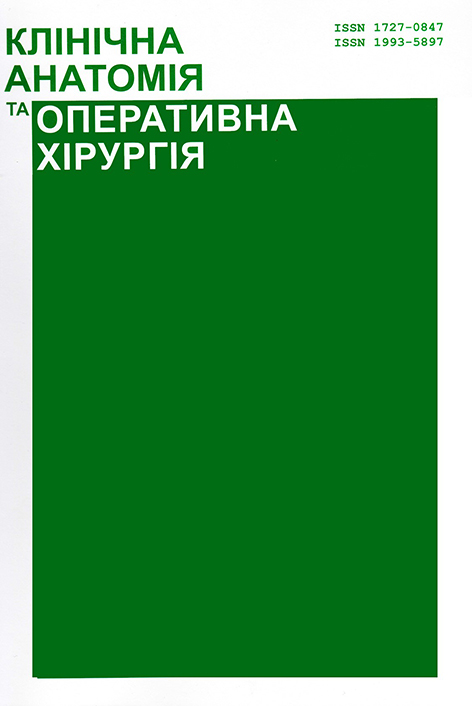АНАЛІЗ ЩІЛЬНОСТІ МЕЛАТОНІНОВИХ РЕЦЕПТОРІВ У НЕЙРОНАХ ПАРАВЕНТРИКУЛЯРНИХ ЯДЕР ГІПОТАЛАМУСА ЩУРІВ ЗА МОДИФІКАЦІЙ ФОТОПЕРІОДУ ТА УВЕДЕННЯ МЕЛАТОНІНУ
DOI:
https://doi.org/10.24061/1727-0847.14.4.2015.20Ключові слова:
мелатонінові рецептори, паравентрикулярні ядра, гіпоталамус, імуногістохімічний аналізАнотація
У статті шляхом імуногістохімічного аналізу охарактеризовано щільність мелатонінових рецепторів 1а типу в медіальних дрібноклітинних суб’ядрах паравентрикулярного ядра гіпоталамуса щурів і встановлено її чіткий циркадіанний ритм. У середньому найвища щільність рецепторів відмічається о 02.00 год доби, а о 14.00 год вона суттєво знижується. Модифікація фотоперіоду спричиняє виражений десинхроноз добових коливань щільності досліджуваних структур. При застосуванні мелатоніну на тлі тривалого освітлення спостерігали вірогідне зростання показника щодо такого у тварин, яким на тлі світлового стресу препарат не уводили, з тенденцію до його нормалізації.Посилання
Khlebnikov VV, Kuznetsov SL, Chernov DA. Vozrastnye osobennosti gipotalamo-gipofizarno-nadpochechnikovoy sistemy pri khronicheskom geterotipicheskom stresse [Age features of the hypothalamic-pituitary-adrenal system in case of chronic heterotypic stress]. Morphology. 2015; 1:15-20 (in Russian).
Tkachuk SS. Neuroendocrine and biochemical mechanisms of stress- limiting and stress-realizing disorders of the brain of rats with syndrome prenatal stress. PhD in Medicine sci. diss. Kyiv, 2000 (in Ukrainian).
Isobe Y, Nishino H. Signal transmission from the suprachiasmatic nucleus to the pineal gland via the paraventricular nucleus: analysed from arg-vasopressin peptide, rPer2 mRNA and AVP mRNA changes and pineal AA-NAT mRNA after the melatonin injection during light and dark periods. Brain Res. 2004; 1013 (2): 204-211.
Abramov AV, Kolesnik YuM. Immunomoduliruyushchiy svoystva gipotalamicheskikh neyropeptidov [Immunomodulating properties of hypothalamic neuropeptides]. Pathology.2004; 1 (1): 14-21 (in Russian).
Kiessling S, Sollars PJ, Pickard GE. Light stimulates the mouse adrenal through a retinohypothalamic pathway independent of an effect on the clock in the suprachiasmatic nucleus. PLoS One. 2014; 9 (3): 929-959.
Alamilla J, Aguilar-Roblero R. Glutamate and GABA neurotransmission from the paraventricular thalamus to the suprachiasmatic nuclei in the rat. J. Biol. Rhythms. 2010; 25 (1): 28-36.
Venegas C, Garcіa JA, Escames G. Extrapineal melatonin: analysis of its subcellular distribution and daily fluctuations. J. Pineal Res. 2012; 52 (2): 217-227.
Bulyk RYe. Shchilnist melatoninovykh retseptoriv 1a typu v neironakh hipokampa bilykh shchuriv vprodovzh doby: imunohistokhimichnyi analiz [The density of melatonin receptor type 1a of hippocampal neurons of white rats throughout the day, immunohistochemical analysis]. Journal of Morphology. 2008; 14 (1): 69-71 (in Ukrainian).
Lacoste B, Angeloni D, Dominguez-Lopez S. Anatomical and cellular localization of melatonin MT1 and MT2 receptors in the adult rat brain. J. Pineal Res. 2015; 58 (4): 397-417.
Ikegami T, Azuma K, Nakamura M. Diurnal expressions of four subtypes of melatonin receptor genes in the optic tectum and retina of goldfish. Comp. Biochem. Physiol. A Mol. Integr. Physiol. 2009; 152 (2): 219-224.
##submission.downloads##
Опубліковано
Номер
Розділ
Ліцензія
Авторське право (c) 2017 Клінічна анатомія та оперативна хірургія

Ця робота ліцензується відповідно до Creative Commons Attribution-NonCommercial-ShareAlike 4.0 International License.
ВІДКРИТИЙ ДОСТУП
а) Автори залишають за собою право на авторство своєї роботи та передають журналу право першої публікації цієї роботи на умовах ліцензії Creative Commons Attribution License, котра дозволяє іншим особам вільно розповсюджувати опубліковану роботу з обов'язковим посиланням на авторів оригінальної роботи та першу публікацію роботи у цьому журналі.
б) Автори мають право укладати самостійні додаткові угоди щодо неексклюзивного розповсюдження роботи у тому вигляді, в якому вона була опублікована цим журналом (наприклад, розміщувати роботу в електронному сховищі установи або публікувати у складі монографії), за умови збереження посилання на першу публікацію роботи у цьому журналі.
в) Політика журналу дозволяє і заохочує розміщення авторами в мережі Інтернет (наприклад, у сховищах установ або на особистих веб-сайтах) рукопису роботи, як до подання цього рукопису до редакції, так і під час його редакційного опрацювання, оскільки це сприяє виникненню продуктивної наукової дискусії та позитивно позначається на оперативності та динаміці цитування опублікованої роботи (див. The Effect of Open Access).



